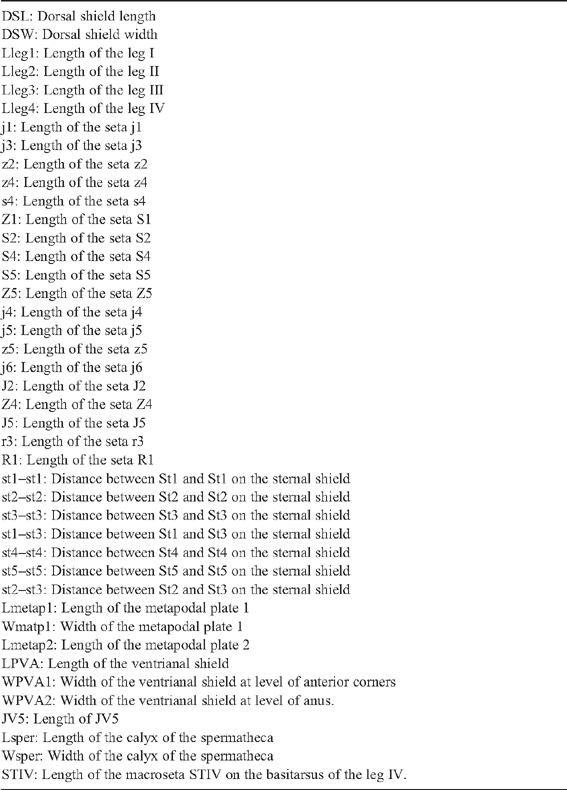Morphological variation in the biological control agent Neoseiulus californicus (McGregor) (Acari : Phytoseiidae): consequences for diagnostic reliability and synonymies
Marie-Stéphane Tixier A B , Sabine Guichou A and Serge Kreiter AA Montpellier Sup Agro / Institut National de la Recherche Agronomique Unité Mixte de Recherche n° 1062 Centre de Biologie et de Gestion des Populations, 2 Place Pierre Viala, bât. 16, 34060 Montpellier cedex 01, France.
B Corresponding author. Email: tixier@supagro.inra.fr
Invertebrate Systematics 22(4) 453-469 https://doi.org/10.1071/IS07052
Submitted: 8 October 2007 Accepted: 4 July 2008 Published: 14 October 2008
Abstract
The extent intraspecific variation among 42 morphological characters within Neoseiulus californicus (McGregor) (Acari : Phytoseiidae) is examined. Neoseiulus californicus is an important biological control agent used commercially worldwide to control pest mites in many crops. The correct diagnosis of this species is thus of prime importance for successful biological control and agricultural development. Incorrect interpretation of intraspecific variation could lead to misidentification and potentially to the description of new species that may be invalid. Three hundred female N. californicus representing ten populations collected from all over the world were measured and compared with the types of two morphologically close species: Neoseiulus marinus (Willmann) and Neoseiulus ornatus (Athias-Henriot). Significant differences between the populations were observed for almost all of the characters considered. However, these differences were small and low within-population standard errors in measurement data were observed. The mites collected in Chile were very different from the specimens of the other populations of N. californicus considered. The level of intraspecific morphological variation found within N. californicus indicates that caution must be applied to correctly determine species boundaries within this genus and morphological variation needs to be considered more in species’ descriptions. Based on our morphological analysis we conclude that N. ornatus, N. marinus and N. californicus are valid species. Redescriptions of these three species are given in this paper.
Additional keywords: morphology, Neoseiulus marinus, Neoseiulus ornatus, redescriptions, taxonomy.
Acknowledgements
We are very grateful to the curators at the Muséum National d’Histoire Naturelle in Paris and the Zoologische Staatssammlung in Munich for lending us the types of Neoseiulus marinus and Neoseiulus ornatus, respectively. We also thank all the scientists who provided the mites for this study: Dr Castagnoli and Dr Liguori for the Italy (Tuscany) population, Dr Ferragut for the Spanish population, Dr Ragusa for the Italy (Sicily) population, Dr de Moraes for the Brazilian population, Dr Gotoh for the Japanese population, Dr Broufas for the Greek population, Dr Lebdi-Grissa for the Tunisian population and Dr Vargas for the Chilean mite population. Finally, we would like to give special thanks to Dr Ragusa for his advice on this paper.
Athias-Henriot C.
(1957) Typhlodromus ornatus n. sp. et Typhlodromus longilaterus n. sp. (Acarina: Phytoseiidae) mésostigmates prédateurs d’Algérie. Revue de Pathologie Végétale et d’Entomologie Agricole de France 36(4), 215–222.
[Verified July 2008].
Swirski E., Amitai S.
(1982) Notes on predacious mites (Acarina: Phytoseiidae) from Turkey, with description of the male of Phytoseius echinus Wainstein and Arutunjan. Israel Journal of Entomology 16, 55–62.

Tixier M.-S.,
Kreiter S.,
Cheval B., Auger P.
(2003) Morphometric variation between populations of Kampimodromus aberrans (Oudemans) (Acari: Phytoseiidae). Implications for the taxonomy of the genus. Invertebrate Systematics 17(2), 349–358.
| Crossref | GoogleScholarGoogle Scholar |

Tixier M.-S.,
Kreiter S.,
Croft B. A., Cheval B.
(2004) Morphological and molecular differences in the genus Kampimodromus Nesbitt. Implications for taxonomy. Phytophaga 14, 361–375.

Tixier M.-S.,
Kreiter S.,
Barbar Z.,
Ragusa S., Cheval B.
(2006) The status of two cryptic species: Typhlodromus exhilaratus Ragusa and Typhlodromus phialatus Athias-Henriot (Acari: Phytoseiidae): consequences for taxonomy. Zoologica Scripta 35, 115–122.
| Crossref | GoogleScholarGoogle Scholar |

Vacante V., Nucifera A.
(1987) Gli Acari degli agrumi in Italia. II. I Gamasidi (Phytoseiidae Berlese e Ascidae Voigts & Oudemans): chiave per il riconoscimento dei e delle specie e note di biologia. Bolletino de Zoologia Agraria e Bachicoltura, serie II 19, 145–184.

Van der Merwe G. G.
(1968) A taxonomic study of the family Phytoseiidae (Acari) in South Africa with contributions to the biology of two species. Entomology Memoirs. South Africa Department of Agricultural Technical Services 18, 1–198.

Willmann C.
(1952) Die Milbenfauna der Nordseeinsel Wangerooge. Veroeffentlichungen Institut fur Meeresforsch, Bremerhaven 1(2), 139–186.


|


